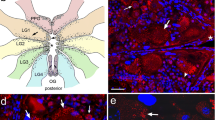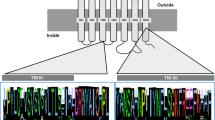Summary
The importance of peptides as intercellular messengers is discussed. The view is put forward that peptides evolved early in evolution as chemical messengers and that they have come to exert a wide range of actions. Using as an example the FMRFamide (Phe-Met-Arg-Phe-NH2) related peptide family of molluscs, the wide range of peptide actions on membrane currents is discussed and considered in relation to co-localization of peptides with low molecular weight (or “classical”) intercellular messengers.
Access this chapter
Tax calculation will be finalised at checkout
Purchases are for personal use only
Preview
Unable to display preview. Download preview PDF.
Similar content being viewed by others
References
Baux, G., Fossier, P. and Tauc, L. (1990) Histamine and FLRFamide regulate acetylcholine release at an identified synapse in Aplysia in opposite ways. J. Physiol. 429, 147–168
Brezina, V. (1988) Guanosine 5′-triphosphate analogue activates potassium current modulated by neurotransmitters in Aplysia neurones. J. Physiol. 407, 15–40.
Brussard, A. B., Ter Mat, A., De Vlieger, T. A. and Kits, K. S. (1990) Inhibitory modulation of neuronal voltage-dependent sodium current by Phe-Met-Arg-Phe-amide. Neurosci. Lett. 111, 325–332.
Cottrell G. A. and Davies, M. W. (1987) Multiple receptor sites for a molluscan peptide (FMRFamide) and related peptides of Helix. J. Physiol. 382, 51–68.
Cottrell, G. A., Green, K. A. and Davies, N. W. (1990) The neuropeptide Phe-Met-Arg-Phe-NH2 (FMRFamide) can activate a ligand-gated ion channel in Helix neurones. Pfiugers Arch. 416, 612–614.
Cottrell, G. A. and Lesser, W. (1987) A comparison of the effect of some molluscan (FMRFamide-like) peptides on the calcium current of a snail neurone. J. Physiol. 392, 33 P.
Cottrell, G. A., Price, D. A., Doble, K. E., Hettle, S., Sommerville, J. and Macdonald, J. (1992) Identified Helix neurons: Mutually exclusive expression of the tetrapeptide and heptapeptide members of the FMRFamide family. Biol. Bull. In press.
Falconer, S. (1992) Mechanisms underlying two different FMRFamide ionic currents in identified neurones of Helix aspersa. PhD Thesis, St Andrews University, UK.
Grimmelikhuijzen, C. J. P., Groeger, A. and Macfarland, I. D. (1987) Neuropeptides in invertebrates, in: Nervous Systems in Invertebrates, pp. 105–132. Ed. M. A. Ali. Plenum Press, New York and London.
Herskowitz, I. and Marsh, L. (1987) Conservation of a receptor/signal transduction system. Cell 50, 995–996.
Ichinose, M. and Macadoo, D. J. (1989) The cyclic GMP-induced inward current in neuron R14 of Aplysia californica: similarity to FMRFamide-induced inward current. J. Neurobiol. 20, 10–24.
Lindsay, R. M. and Harmar, A. J. (1989) Nerve growth factor regulates expression of neuropeptide genes in adult sensory neurones. Nature 337, 362–364.
Man-Son-Hing, H., Zoran, M. J., Lukowiak, K. and Haydon, P. G. (1989) A neuromodulator of synaptic transmission acts on the secretory apparatus as well as ion channels. Nature 341, 237–239.
Piomelli, D., Volterra, A., Dale, N., Siegelbaum, S. A., Kandel, E. R., Schwartz, J. H. and Berlardetti, F. (1987) Lipoxygenase metabolites of arachidonic acid as second messengers for presynaptic inhibition of Aplysia sensory neurones. Nature 328, 38–43.
Shimomura, O., Suthers, H. L. B. and Bonnar, J. T. (1982) Chemical identity of the acrasin of the cellular slime mould Polyphondylium violaceum. Proc. Natl. Acad. Sci. USA 79, 7376–7379.
Stotzler, D., Kiltz, H.-H. and Duntze, W. (1976) Primary structure of α-factor peptides from Saccharomyces cerevisiae. Eur. J. Biochem. 69, 397–400.
Thompson, S. and Ruben, P. (1988) Inward rectification in response to FMRFamide in Aplysia neuron LZ: Summation with transient K current. J. Neurosci. 8, 3200–3207.
Author information
Authors and Affiliations
Editor information
Editors and Affiliations
Rights and permissions
Copyright information
© 1993 Birkhäuser Verlag Basel/Switzerland
About this chapter
Cite this chapter
Cottrell, G.A. (1993). The wide range of actions of the FMRFamide-related peptides and the biological importance of peptidergic messengers. In: Pichon, Y. (eds) Comparative Molecular Neurobiology. EXS, vol 63. Birkhäuser Basel. https://doi.org/10.1007/978-3-0348-7265-2_15
Download citation
DOI: https://doi.org/10.1007/978-3-0348-7265-2_15
Publisher Name: Birkhäuser Basel
Print ISBN: 978-3-0348-7267-6
Online ISBN: 978-3-0348-7265-2
eBook Packages: Springer Book Archive




